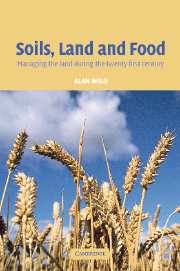Book contents
- Frontmatter
- Contents
- Preface
- Acknowledgements
- 1 Managing land for food production in the twenty-first century: an outline
- 2 Natural resources for sustainable land management
- 3 The development of agriculture and systems of land management
- 4 Maintaining and improving soil fertility
- 5 Land degradation and its control
- 6 Raising yields: use of fertilizers
- 7 Raising yields: water for rainfed crops and irrigation
- 8 Managing change of land use: seven examples
- 9 Increasing and sustaining agricultural production
- 10 Increasing agricultural production: the examples of Africa, India and China
- 11 Prospects and uncertainties
- References
- Index
4 - Maintaining and improving soil fertility
Published online by Cambridge University Press: 05 June 2012
- Frontmatter
- Contents
- Preface
- Acknowledgements
- 1 Managing land for food production in the twenty-first century: an outline
- 2 Natural resources for sustainable land management
- 3 The development of agriculture and systems of land management
- 4 Maintaining and improving soil fertility
- 5 Land degradation and its control
- 6 Raising yields: use of fertilizers
- 7 Raising yields: water for rainfed crops and irrigation
- 8 Managing change of land use: seven examples
- 9 Increasing and sustaining agricultural production
- 10 Increasing agricultural production: the examples of Africa, India and China
- 11 Prospects and uncertainties
- References
- Index
Summary
INTRODUCTION
By the middle of the nineteenth century a world population of about 1.2 billion cultivated an area estimated at 0.4 × 109 ha. Based on data reported by Evans (1997) and Greenland (1997), the average yields of wheat were probably about 1 t ha-1 and rice about 1.5–2 t ha-1. Cultivations were by hand or by animal-drawn implements and crop harvesting was by sickle or scythe. The small increases in crop yield during preceding centuries had been by selection of varieties. Nutrients were recycled, with the only additional inputs being from river silt, the weathering of minerals derived from rocks, and biological nitrogen fixation. Pest control depended on the use of fallows and rotations, and the area of irrigation had increased little during the previous 2000 years. All this changed as an increased population demanded more food.
Later chapters describe how food production has increased in the last 150 years, and will continue to do so in the future, through the use of manufactured fertilizers, water conservation and irrigation, pesticides, and increases in crop yield potential. However, success in obtaining the required output of food ultimately depends on soil fertility, defined as the capacity of the soil to produce the required crop yield.
Soil properties and processes can be physical, chemical or biological (see Chapter 2). Each of these affects soil fertility either independently or, more usually, by interaction to produce a synergistic effect.
- Type
- Chapter
- Information
- Soils, Land and FoodManaging the Land during the Twenty-First Century, pp. 51 - 68Publisher: Cambridge University PressPrint publication year: 2003



